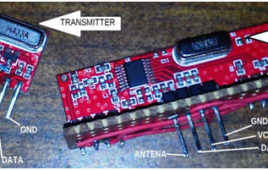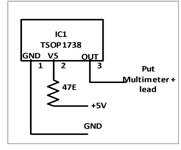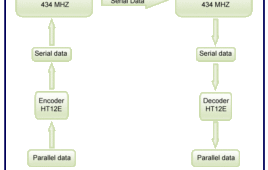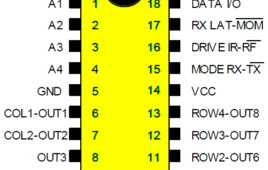by Ken Ghadia, Sales Engineer, TechnoTronix Radio Frequency (RF) PCBs are very high-speed circuits operating at frequencies in the range of 100MHz and above, typically from 500MHz to 2 GHz. RF PCBs are the backbone of wireless networks, high-tech gadgets like smartphones, smart TVs, etc. Also, RF PCBs are used in automotive, medical equipment, military,…
STMicroelectronics and Tower partner to accelerate ST Agrate R3 300mm fab production
STMicroelectronics, a global semiconductor provider, is partnering with Tower Semiconductor, which offers high-value analog semiconductor solutions. ST will welcome Tower to its Agrate R3 300mm fab under construction on its Agrate Brianza site in Italy. Together, ST and Tower will join forces for an accelerated fab ramp-up — a key factor to reach a high-use…
Controlling Appliances Wirelessly using RF Technology
Now a day’s everyone needs a device which could control appliances wirelessly. This makes us to operate them on our fingertips from particular vicinity with ease.This time I have done something like this, I have created a prototype of a device which controls 4 devices/appliances separately using RF (Radio Frequency) technology. The device comprises of two sections: Transmitting (remote) and Receiving part. The transmitting part works as a remote device to send the corresponding data to the receiver section. It further consists of 4 SPDT (single pole double throw) switch, one Encoder IC (HT12E) and a TX module (433 MHz). These 4 switches are connected to the 4 data pins of the encoder IC to generate a 4-bit data to be transmitted. The switches provide either high (+5V) or low (0V) signal levels.
IR to RF Converter
Here we have presented a simple circuit using which you can convert IR signal into RF signals and at the same time transmit this to remote location and decode them using a compatible RF receiver. With help of this circuit you can increase the range of the device you are controlling up to 200 meters
RF based Wireless Remote Control
The circuit of this project utilises the RF module (Tx/Rx) for making a wireless remote, which could be used to drive an output from a distant place. RF module, as [[wysiwyg_imageupload::]]the name suggests, uses radio frequency to send signals. These signals are transmitted at a particular frequency and a baud rate. A receiver can receive these signals only if it is configured for that frequency.A four channel encoder/decoder pair has also been used in this system. The input signals, at the transmitter side, are taken through four switches while the outputs are monitored on a set of four LEDs corresponding to each input switch.The circuit can be used for designing Remote Appliance Control system. The outputs from the receiver can drive corresponding relays connected to any household appliance. Read more to find out how the circuit is assembled and made to work
RF Remote Control using Codec Chip ST14
Here to make a IR remote control I am using an ASIC codec chip ST12 where codec means coder decoder. That means same chip is used as encoder at transmitter side and as decoder at receiver side. It’s very nice chip and some of the major features of the chip are Encode / Decode on…
Swarm Robotics
“When everybody thinks alike, nobody is thinking much”, is so rightly said. Think out-of-the-box and you potent some innovation or maybe an invention; credits to your gamut. To speak in line with the concept here, swarming population; not always, is a bad idea. How about rescuing some disaster hit zone with swarming intelligent population or maintaining a warehouse with moving, self-operational shelves?? A great idea indeed. Everybody must have noticed the movement of ants or similar insects. It is awesomely coordinated and aligned with respect to each other. They accomplish their task collectively by keeping an eye on each other’s movement. This type of coordinated movement in insects is termed as Swarm and when this movement is performed by some group of robots then in technical terms it is called as “Swarm Robotics” inspired by colonies of ants and swarms of bees.
Bluetooth Technology : An overview
Bluetooth is a wireless technology used to transfer data between different electronic devices. The distance of data transmission is small in comparison to other modes of wireless communication. This technology permits hands free headset for incoming voice calls, ability of printing and fax, and automatic synchronization of PDA. A Bluetooth device is comprise of an adapter. A Bluetooth adapter can be available in the form of a card to connect the device or integrated into an electronic device. Link Management Protocol (LMP) is responsible for peer – to – peer message exchange when the electronic devices interfere in each other’s radio range.
Wireless motor control through RF
Wireless remote controlled toy cars work on the concept explained in this project. Motor control through RF communication is a very interesting application and [[wysiwyg_imageupload::]]is widely used in robotics, electronics toys, automation systems etc. This topic covers the way DC motors can be driven by using the controls from a distant place. The controls are transferred from one end to another by employing an RF module. The parallel signals generated at transmission end are first encoded (into serial format) by HT12E and then transferred through RF transmitter (434 MHz) at a baud rate of around 1-10 kbps. The same signals are acquired by RF receiver after which it is decoded by HT12D. For more details, refer RF remote control.
RF based Fire Alarm (Overheat Alarm)
This project presents another application of RF (radio frequency) communication. The capability of fire alarm circuit can be improved by incorporating an RF [[wysiwyg_imageupload::]]module. This way the temperature sensor and buzzer for alarm can be placed away from each other. This provides flexibility in installing various sensors at different locations in a building and thus overheating at a place (due to fire) would signal the buzzer to go on. This project about fire alarm circuit can be divided into four parts, namely, temperature sensor, comparator, transceiver part (RF module) and the output. In this circuit a temperature sensor (LM35) is placed at a certain place and its output is given to the negative end of a comparator. LM324 has been provided in the circuit for comparator. The positive end of comparator is connected to a preset, to set the reference temperature. As long as the output of temperature sensor is below the set reference, the output of comparator stays high.
RF based Intruder Alarm
This project extends the functionality of intruder alarm to alert a user at a distant location. The intrusion can be detected at a faraway place by making use of RF [[wysiwyg_imageupload::]]communication. For this purpose, an RF module can be used as has been explained here. This project about intruder alarm circuit can be divided into three parts, namely, IR circuit, transceiver part and the output. The IR circuit is used as a sensor to detect an intrusion in its proximity. RF module works as the transceiver here. For more details, refer wireless RF remote. The transceiver transmits the signal generated by IR sensor. It provides this signal to the data pin of decoder IC. The output part consists of a NOT gate IC 74LS04 (to invert the low signal) and a buzzer to alert the user. Read more to find out how the circuit is constructed and how it works.








